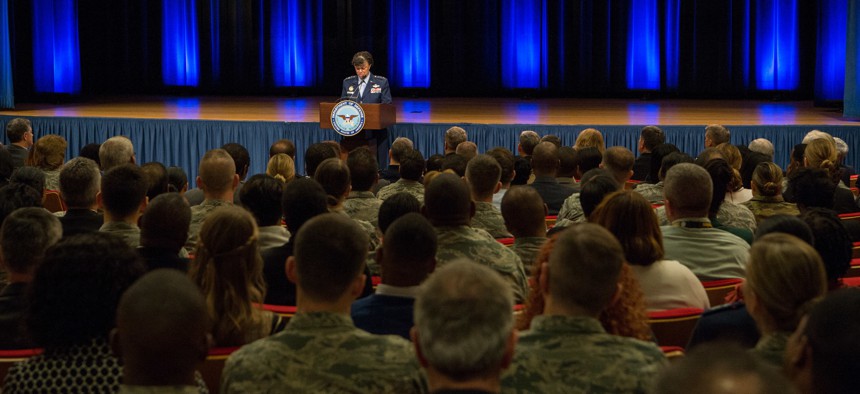
Staff Sgt. Jette Carr
Pentagon Misses the Target When It Comes to Its Workforce
Defense officials can’t tell you how many contractors they employ or at what cost. Finding out is critical to personnel reform.
The Pentagon is the only federal agency that has not been able to pass an audit since Congress required federal agencies to be audited nearly a quarter of a century ago. It’s not surprising, as I don’t think any senior leader inside the Defense Department even knows how many people are on the payroll of the military, civilian, and contractor workforces. Also, none of them can tell us about workforce costs and how personnel reforms could save billions of dollars.
Recently, the House Armed Services Committee held a hearing to gather ideas on achieving greater efficiency inside the Pentagon. One subject that was raised—which deserves a lot more attention—is something called rightsizing the DoD workforce. In plain English, that means figuring out how many employees DoD needs and how much it should spend on personnel.
Former Undersecretary of Defense for Policy Michèle Flournoy testified that a human capital strategy is important for the agency. She said:
This [strategy] should include an assessment of the optimal mix of military, civilian, and contractor personnel across the department and by function.
Of note, a recent study by the Congressional Budget Office found that shifting 80,000 positions from military to civilian personnel, and eliminating the military positions, could save the federal government $3.1 billion to $5.7 billion a year once fully implemented. Optimizing the mix of contractors and civilian employees would undoubtedly save money as well.
A Secretary-directed Human Capital Strategy that would inform DoD’s planning, programming, budgeting, and evaluation process and determine the optimal mix of military, civilian, and contractor personnel would be a powerful enabler for reshaping the Department for the future.
John Hamre of the Center for Strategic and International Studies, testified, “We need to look honestly at the price of labor—uniformed service labor, civil service labor, and contractor-provided labor. We do not honestly show the fully burdened costs and compare them objectively.”
I couldn’t agree more.
Since 2011, the Project On Government Oversight has been mortified by the lack of effort inside DoD and Congress to better understand who is performing work at the Pentagon and the costs of the agency’s mixed workforce. Certainly there is a need for contractors to supply goods and services to the federal government. However, there is a culture within Defense that is committed to transferring to contractors responsibilities that are most cost-effective when performed by Defense civilians.
We have exposed internal and external studies showing that civilian employees offer the best bang for the buck when compared to military and contractor personnel. I have personally been contacted by government officials who described situations where hiring contractors resulted in higher costs than would have been incurred if civilian employees had performed the work.
Nonetheless, there has been little movement to properly inventory all three workforces, and review the work, performance, and costs of each. As a result, funds that could be provided for critical readiness needs are squandered.
In fact, contractors are so resistant to any such proposal that they have been arguing to eliminate the inventory of service contractors. Albeit of limited use in its current form because the inventories don’t provide the data needed to compare the relative cost of performance by federal employees versus contractors, the inventories are the only yardstick for learning about the costs, number of contractor employees, and types of services being performed.
Despite the numerous outside experts telling Congress that the DoD needs to strategically balance its workforce to improve outcomes, save money, and bolster military readiness in the long run, I predict we will see more of the same. The Pentagon and Congress will continue their efforts to avoid genuine cost comparisons and ignore the math.
Here’s a novel idea: Congress should hold a hearing on the DoD workforce, and instead of inviting senior-level appointees to testify, it should seek input from the managers who are familiar with personnel issues, specifically Department of Defense Instruction 7041.04 (“Estimating and Comparing the Full Costs of Civilian and Active Duty Military Manpower and Contract Support”).
Invite those experts to bring cost comparisons and allow them to testify about ways to obtain the most appropriate and cost effective workforce. It would be ill-informed to continue to require workforce changes and pay a price premium at the same time.



